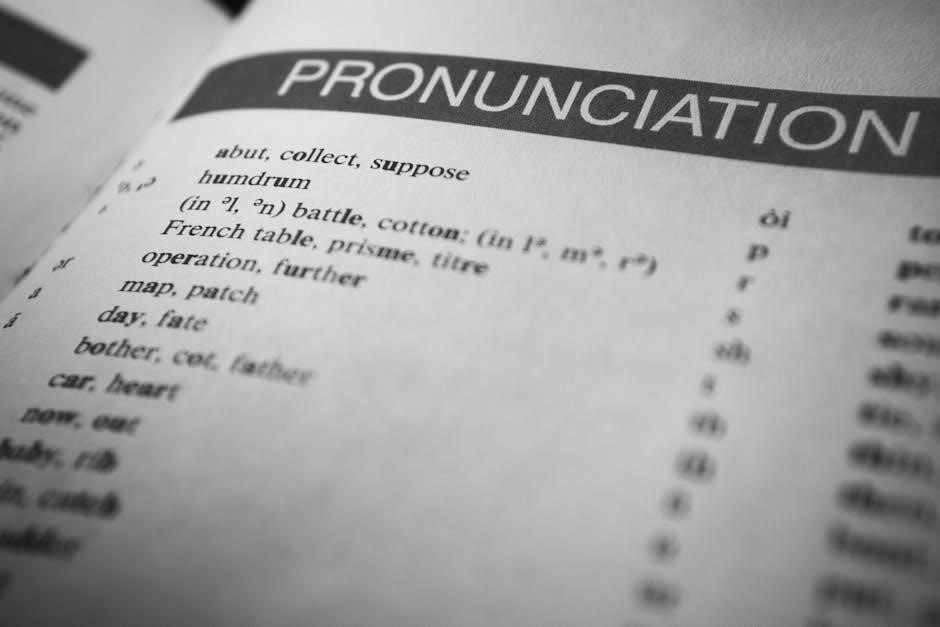A mower belt cross-reference guide is an essential tool for quickly identifying the correct replacement belts for your equipment‚ ensuring proper fitment and optimal performance while minimizing downtime.
What is a Cross-Reference Guide?
A cross-reference guide is a comprehensive tool designed to help users identify equivalent parts or components across different manufacturers. For mower belts‚ it maps one manufacturer’s belt number to another’s‚ ensuring compatibility and proper fitment. This guide eliminates guesswork by providing direct comparisons‚ saving time and reducing errors. It is particularly useful when the original equipment manufacturer (OEM) part is unavailable or when seeking cost-effective alternatives. Cross-reference guides often include detailed charts‚ size specifications‚ and application information‚ making them indispensable for maintenance and repairs. They are widely used by professionals and DIYers alike to simplify the replacement process and ensure optimal performance of machinery.
Why Use a Mower Belt Cross-Reference Guide?
A mower belt cross-reference guide is essential for ensuring proper belt fitment‚ optimal performance‚ and preventing costly equipment damage. It helps users quickly identify the correct replacement belts‚ minimizing downtime and extending machinery lifespan. By providing direct comparisons across manufacturers‚ the guide eliminates guesswork and reduces errors in belt selection. This tool is particularly valuable when the original part is unavailable or when seeking cost-effective alternatives. It also helps maintain equipment efficiency and avoid premature wear caused by incorrect belt sizing. Using a cross-reference guide ensures that repairs are faster‚ more accurate‚ and cost-effective‚ making it a vital resource for both professionals and DIY enthusiasts.
Importance of Proper Belt Fitment
Proper belt fitment is crucial for the efficient operation of your mower. A well-fitting belt ensures smooth power transmission‚ reduces wear on pulleys‚ and prevents premature belt failure. Incorrect sizing can lead to slippage‚ reduced performance‚ and increased risk of equipment damage. Additionally‚ improper fitment can cause vibrations‚ noise‚ and overheating‚ which may result in costly repairs. Correct belts also ensure safety by maintaining consistent machine operation. Referencing a cross-guide helps achieve precise measurements‚ guaranteeing optimal performance and longevity of both the belt and the mower. Proper fitment is essential for reliability‚ efficiency‚ and extending the lifespan of your equipment.

Understanding Mower Belt Types and Sizes
Mower belts vary by type‚ with V-belts being the most common‚ offering different cross-sections (A‚ B‚ C‚ D‚ E) for specific applications. Proper sizing ensures optimal performance.
Common V-Belt Cross-Sections (A‚ B‚ C‚ D‚ E)
V-belts are classified into standard cross-sections: A‚ B‚ C‚ D‚ and E. Each section has specific width and depth dimensions‚ with A being the smallest and E the largest. These cross-sections determine the belt’s load-carrying capacity and compatibility with pulleys. For instance‚ A-section belts are typically used for lighter applications‚ while E-section belts handle heavy-duty operations. Proper identification of cross-sections is crucial for ensuring correct fitment and performance in mower applications. Always refer to manufacturer guidelines or cross-reference charts to select the appropriate belt size for your equipment. This ensures optimal functionality and extends the lifespan of your mower’s belts.
How to Measure Belt Length and Width
To accurately measure a mower belt‚ start by laying it flat. Use a flexible tape measure or ruler to determine the inside length‚ which is the distance between the two ends of the belt‚ excluding the v-shaped part. Next‚ measure the width by checking the distance across the belt’s top. These measurements are crucial for selecting the correct replacement. For worn belts‚ allow for some stretch when ordering. Always refer to the manufacturer’s specifications or cross-reference guides to ensure precise fitment. Accurate measurements prevent operational issues and ensure optimal performance of your mower’s belts.
Understanding Belt Part Numbers
Belt part numbers are unique identifiers that provide critical information about the belt’s specifications. Typically‚ these numbers include a combination of letters and digits‚ where letters indicate the belt type (e.g.‚ A‚ B‚ C for V-belt cross-sections) and digits represent the inside length in inches. Additional suffixes or prefixes may denote special features‚ materials‚ or manufacturer-specific details. For example‚ a part number like “A42” signifies a type A V-belt with a 42-inch inside length. Understanding these codes is essential for accurate cross-referencing and ensures the correct replacement belt is selected. Always refer to the manufacturer’s guide or cross-reference charts for precise matching.

Locating Your Mower’s Model and Part Numbers
Locating your mower’s model and part numbers is crucial. Check the owner’s manual‚ OEM website‚ or areas like under the hood or seat for these details to ensure accurate belt identification.
Where to Find the Model Number
Locating the model number is the first step in identifying the correct mower belt. It is typically found in the owner’s manual or on the mower itself. Check under the hood‚ on the side of the fuel tank‚ or under the seat. Some models display it on the engine or mower deck. The model number is also available on the manufacturer’s website or through their customer support. Ensure the number is accurate to avoid mismatches. For example‚ in some cases‚ the model number may be listed as “EXP33” or “Tiller 5HP Rocket.” Always cross-reference this number with the belt cross-reference guide for precise results.
Where to Find the Serial Number
The serial number is crucial for accurate belt cross-referencing and is usually located on the mower itself. Check under the hood‚ on the engine block‚ or near the mower deck. It may also be found on the side of the fuel tank or on a metal plate attached to the frame. Some models display the serial number on the transmission or rear axle. If you cannot locate it on the equipment‚ refer to the owner’s manual or visit the manufacturer’s website. The serial number often starts with specific prefixes‚ such as “05990612” or “03001292‚” which are vital for identifying the correct belt. Always verify the serial number to ensure precise cross-referencing and avoid sizing errors.
Extracting Belt Part Numbers from Manuals
Extracting belt part numbers from your mower’s manual is straightforward. Look for sections labeled “Parts List” or “Specifications‚” where belt details are typically listed. Belts are often identified by their application‚ such as “Deck Belt” or “Cutter Drive Belt‚” followed by specific part numbers like “EXP33” or “582 64 59-01.” These numbers may be highlighted or grouped in charts for easy reference. Ensure you cross-reference these numbers with a cross-reference tool to confirm compatibility and accuracy. Always double-check the manual for any additional notes or diagrams that may aid in identifying the correct belt for your mower. This step is crucial for ensuring proper fitment and performance.

How to Use a V-Belt Cross-Reference Tool
Locate the belt part number on the belt or in the manual.
Enter the part number or mower model into the tool.
Review the results for compatible belts from various brands.
Match the size and type to ensure proper fitment.
Use the tool’s guides to confirm measurements and applications.
This method ensures accurate replacements‚ saving time and minimizing errors.
Step-by-Step Guide to Cross-Referencing Belts
Identify the belt part number‚ usually found on the belt or in the owner’s manual.
Enter the part number into the cross-reference tool or search by mower model.
Compare the results with your current belt’s measurements (width and length).
Verify the cross-section type (A‚ B‚ C‚ D‚ E) to ensure compatibility.
Check the application (e.g.‚ deck belt‚ cutter drive belt) to confirm suitability.
Review the manufacturer’s recommendations for equivalent belts.
Double-check the fitment details to avoid sizing discrepancies.
Consult the user manual if unsure about specific requirements.
This process ensures accurate replacements‚ minimizing errors and downtime for your mower.
Using Brand-Model Search for Accurate Matches
Using a brand-model search enhances accuracy when cross-referencing mower belts. Start by locating your mower’s model number‚ typically found in the owner’s manual‚ on the manufacturer’s website‚ or on the equipment itself (e.g.‚ under the hood or on the side of the fuel tank). Enter the model number into the cross-reference tool’s brand-model search tab to retrieve a list of compatible belts. This method bypasses the need to manually input part numbers‚ reducing errors. Ensure the search tool includes major brands like Gates‚ Dayco‚ and Bando for a comprehensive match. Always verify the results with your mower’s specifications for optimal performance and longevity.
Interpreting Cross-Reference Results
When using a cross-reference tool‚ the results will display equivalent belts from various manufacturers‚ ensuring compatibility with your mower. Pay attention to the part numbers‚ dimensions‚ and types (e.g.‚ A‚ B‚ or C sections). Verify that the recommended belts match your mower’s specifications‚ including length‚ width‚ and material. Some results may include multiple options‚ so prioritize belts from trusted brands like Gates or Dayco. Double-check the application (e.g.‚ deck belt‚ cutter drive) to ensure the belt suits your equipment’s needs. If unsure‚ consult your owner’s manual or contact the manufacturer for clarification to guarantee proper fitment and performance.

Top Manufacturers and Their Belt Cross-References
Leading manufacturers like Gates‚ Dayco‚ Bando‚ and Goodyear offer extensive cross-reference guides‚ ensuring compatibility and performance for various mower belts‚ including V-belts and serpentine belts.
Gates Belt Cross-Reference

Gates belt cross-reference guides provide precise matchings for mower belts‚ ensuring optimal performance and durability. Their extensive database covers various belt types‚ including V-belts and serpentine belts‚ with detailed part numbers and specifications. Users can easily find equivalent Gates belts by inputting competitor part numbers or mower model details. Gates belts are renowned for their high-quality materials and exact fitment‚ making them a top choice for lawn mower maintenance. Their cross-reference tools are designed to simplify the replacement process‚ reducing downtime and ensuring seamless compatibility. Whether for cutter drive belts or deck belts‚ Gates offers reliable solutions for all mower belt needs.
Dayco Belt Cross-Reference
Dayco’s cross-reference guide is a valuable resource for finding the right mower belts efficiently. It offers a comprehensive database of Dayco belts‚ allowing users to search by part number or mower model. Dayco belts are known for their durability and precise fitment‚ ensuring optimal performance for various applications. The guide simplifies the replacement process by providing direct equivalents from other manufacturers‚ making it easier to locate the correct belt. Whether for deck belts‚ cutter drive belts‚ or engine belts‚ Dayco’s cross-reference tool ensures quick and accurate results‚ minimizing downtime and maintaining equipment productivity. Their belts are a reliable choice for lawn mower maintenance and repair.
Bando and Goodyear Belt Cross-References
Bando and Goodyear are prominent manufacturers offering reliable mower belts with precise cross-reference guides. Bando belts are renowned for their durability and resistance to wear‚ while Goodyear belts are celebrated for their high-quality materials and performance. Their cross-reference tools allow users to search by part number or mower model‚ ensuring accurate matches for replacement belts. Both brands provide detailed charts and databases‚ making it easier to find the correct belt for specific applications‚ such as deck belts or cutter drive belts. Their guides are essential for maintaining mower efficiency and reducing downtime‚ ensuring belts are replaced with compatible and high-performing options. These resources are invaluable for DIY enthusiasts and professionals alike.

Common Mower Belt Applications

Mower belts are crucial for various machinery operations‚ including cutter drives‚ deck belts‚ and engine-transmission connections‚ ensuring smooth power transmission across different mower components and systems efficiently.
Cutter Drive Belt
A cutter drive belt is essential for powering the cutting deck on lawn mowers and garden tractors. It transmits power from the engine to the blades‚ ensuring efficient cutting operations. Proper fitment is crucial to avoid slippage or premature wear. Cross-reference guides help identify the correct belt for specific mower models‚ such as EXP33 or EXP40‚ commonly used in ride-on mowers. These belts often have unique part numbers‚ like 120-3892‚ and may vary based on serial numbers‚ such as those starting from 05990612 or 03001292. Using the wrong belt can lead to reduced performance or damage. Always consult the guide to match the correct specifications for your mower’s cutter drive system.

Deck Belt
A deck belt is a critical component that drives the mower deck‚ connecting the engine or transmission to the cutting blades. Proper fitment is essential for optimal performance and longevity. Cross-reference guides help users identify the correct deck belt for their specific mower model‚ such as the Toro Timecutter SS5000‚ using part numbers like 120-3892. These guides often categorize belts by width‚ length‚ and type‚ ensuring accurate replacements. Common deck belts include cogged or wedge belts‚ designed for reduced slippage and increased durability. Always refer to the cross-reference guide to avoid sizing discrepancies and ensure the belt matches your mower’s specifications for reliable operation.
Engine and Transmission Belts
Engine and transmission belts are vital for powering essential mower functions‚ such as blade operation and hydraulic systems. Cross-reference guides simplify finding the right belts for your equipment‚ like Gates A42 or Dayco equivalents. These belts are categorized by cross-sections (A‚ B‚ C‚ D‚ E) and length‚ ensuring precise fitment. Proper belt replacement prevents costly damage and downtime‚ maintaining optimal performance. Always consult the guide to match your mower’s specifications‚ especially for models requiring specific belts like the Toro Timecutter SS5000 or Ride-on 32/38 cut models. Accurate replacements ensure smooth operation and extend the lifespan of your mower’s engine and transmission.

Troubleshooting Belt Replacement Issues
Troubleshooting belt replacement involves identifying common mistakes like incorrect sizing or type‚ addressing discrepancies‚ and ensuring proper fitment to avoid equipment damage and performance issues.
Common Mistakes in Belt Selection
One of the most common mistakes in belt selection is choosing the wrong size or type‚ which can lead to poor performance or equipment damage. Many users overlook the importance of cross-referencing the part number with the manufacturer’s specifications‚ leading to incorrect matches. Another error is not considering the belt’s cross-section‚ as using a belt with the wrong profile can cause misalignment and wear. Additionally‚ some individuals fail to verify the belt’s material and durability for their specific application‚ which can result in premature failure. Always refer to the cross-reference guide to ensure accurate and reliable belt selection for optimal performance and longevity of your mower.
Addressing Belt Sizing Discrepancies
When encountering belt sizing discrepancies‚ it’s crucial to double-check measurements and refer to the cross-reference guide. Ensure the belt’s length and width match the specifications for your mower model. If the original part number is unclear‚ use the guide to find equivalent options from trusted manufacturers like Gates or Dayco. Measure the belt’s inside and outside lengths accurately to avoid mismatches. Consult the OEM manual or online resources for precise sizing; Addressing these issues promptly prevents equipment damage and downtime‚ ensuring smooth operation and extending the lifespan of your mower’s belts.
Using a mower belt cross-reference guide ensures optimal performance and minimizes downtime. Always inspect belts regularly and replace them when worn to maintain your equipment’s longevity and efficiency.
Best Practices for Belt Replacement
Proper belt replacement is crucial for maintaining mower performance. Always use a cross-reference guide to ensure the correct fitment and consult the owner’s manual for specific instructions. Inspect belts regularly for cracks‚ frays‚ or excessive wear. Measure the belt’s length and width accurately to avoid sizing discrepancies. Replace belts immediately if damaged to prevent equipment damage. Use authentic or OEM-equivalent parts for reliability. Store belts in a cool‚ dry place to avoid degradation. Refer to the manufacturer’s recommendations for replacement intervals. By following these practices‚ you can ensure optimal performance‚ reduce downtime‚ and extend the lifespan of your mower’s belts.
Maintaining Your Mower’s Belts for Longevity
Regular maintenance is key to extending the life of your mower’s belts. Inspect belts frequently for signs of wear‚ such as cracks or fraying‚ and clean them to remove debris. Store belts in a cool‚ dry place to prevent material degradation. Avoid exposing them to direct sunlight or chemicals. Proper tensioning is essential; refer to your manual for guidelines. Lubricate pulleys and other moving parts to reduce friction. Replace belts at the first sign of damage to prevent equipment damage. By following these steps‚ you can ensure your belts perform optimally and last longer‚ minimizing downtime and costly repairs.



